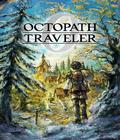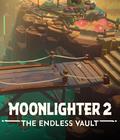Double Fine has a knack for making games with unique premises: a kid attending summer camp for psychics, a group that turned trick-or-treating into a full-blown adventure, and a retro future where heads fly around and take over bodies. Almost every game the developer has made thus far feels different from its contemporaries while also providing a solid gameplay experience. By that standard, Keeper is perhaps one of its strangest games yet in terms of setup, but it retains the studio's record of providing a very satisfying gameplay experience.
Keeper starts with a view of a flock of birds flying away from a mysterious cloud. One of the birds named Twig falls behind from the rest of the flock and gets attacked by the cloud, causing the animal to crash land atop a dilapidated lighthouse. The lighthouse collapses, and the ordeal causes the building to sprout legs made from nearby tree roots. The building itself sentient, so it and its new bird companion begin to roam the world to discover what their newfound purpose is. Their instincts are telling them that the answer might be at the top of the mountain in the island's center.
The story can be tough to explain without getting into spoilers, but there are some elements that make it fascinating. The game takes place in a far-flung future when humans are gone, but there's no emphasis on this in the lore. You'll notice skyscraper ruins and old rusted cars, but no time is spent reminiscing about the past or dwelling on how things could've fared differently.
Another element that makes the story stick is the fact that it's conveyed with actions instead of words. There are no audio logs or written letters to pick up. There's no dialogue, and the game doesn't circumvent this by creating a new language that isn't translated for you. Understanding the story and specific moments depends on you picking up on the body language, leaving room to interpret how things are going except for the most obvious of actions. Some games have attempted to do this before with varying degrees of success, but this title nails it. This attempt only works to its fullest if you don't pay attention to any of the Achievements that pop up; they clearly outline what's going on, so it falls on you to let those Achievements pop up or have them hidden away, depending on your desire to understand what's happening.
The game classifies itself as a puzzle-platformer, but you'd be forgiven if you initially thought it was a walking simulator because that's all you'll be doing during the opening moments. You'll stumble around in the beginning, but it doesn't take long before you're walking from one environment to another. You may start in a wasteland full of rusted cars, but that same area is also the locale of houses that look like they were plucked from a Tim Burton film. This opens up to a system of brightly lit caves and the sides of mountains. You'll traverse fields filled with machinery and pink vegetation, and you'll go through a town full of robots and a few more ruins. There are even a few moments when the space is bathed in psychedelic colors before returning to something more normal. The scenery changes often, but the brushstroke style of the environments makes even the dour areas look beautiful. You'll want to stop and take in each scene for a while before moving on.
As far as platforming goes, don't expect anything too tricky. The most exciting part is some jumping because of the pink flowers you'll find in one area, and even then, the jumping isn't going to be tricky enough that you'll need to repeat a tricky sequence. The game will not let you walk or jump into anything dangerous. You'll never see yourself walk off a cliff, and there are no lethal monsters or bottomless pits. This is a combat-free game, so there's no chance of seeing a "Game Over" screen.
The puzzles are interesting when you consider the abilities you have as a mobile lighthouse. All you can do is shine your light on things and increase the intensity of the light you produce by focusing on an area or object. That might not sound like much until you realize that your light triggers things in the environment, like plants that corrode stone, revealing secrets through false walls, and causing plants to grow and animals to react. In addition to your light, you also have Twig, who can move cranks, pick up items, and act as a weight for certain switches; Twig makes up for the things that the lighthouse can't do.
Keeper uses these abilities quite well, and while some puzzles are basic, such as ones where you focus a light to activate a switch or turn a crank to do something similar, there are other puzzles that are more fascinating in their execution. For example, there are a few that involve time manipulation, so you need to turn Twig into a ghost to pass through an iron grate. Twig turns back into a living bird to have enough weight to lower the switch that opens a door. Another puzzle may have you sending Twig to retrieve mechanical eyeballs that are stuck in plants. Unlike the platforming, there are a few puzzles with solutions that will make you scratch your head, but there's nothing that feels overly obtuse.
The game does a good job of balancing when to have puzzles and when to let the player wander around and take in the scenery. As a whole, the journey from start to end lasts about five hours. While that seems short, it is the perfect length for this game because boredom never sets in. Aside from the aforementioned balancing in platforming and puzzles, the game does a very good job of keeping things fresh by implementing a few changes throughout the journey. Those changes can't be described because they're essential to the story, but they help you realize how the notion of a walking lighthouse can be kept fresh and how an antagonist can exist in a game without combat.
The complaints about the title are few but worth noting. The game purposefully doesn't let you control the camera, and while it works well most of the time, it hurts you in one puzzle because you need to note the orientation of some symbols but have no way of effectively seeing that orientation. This is evident on a symbol that you take a crank from, since you only get a clear view of that symbol when taking out the crank. The same puzzle also demonstrates a lack of hints on whether you're doing things correctly. There are a few clicking sounds that make you think you're on the right track, but it comes down to some dumb luck when trying to solve this mystery.
As mentioned before, the background has a graphical style that is akin to brushstrokes in a painting. You'll see this up close when the camera zooms in on walls and trees, and it gives the game a dreamlike look that goes well with the other environments. As an Unreal Engine title, Keeper does an excellent job of avoiding some of the engine pitfalls, such as texture and model pop-in from far distances. There's no evidence of hitching. Those things alone help make the game an excellent showpiece for graphics, especially since the game supports all of the upscaling technologies without showing any of the downsides due to the artistic style being employed. Like the graphics, the audio is also very well done. The soundtrack is the real highlight, as it does a fantastic job of accentuating the different moods of the adventure and match the environments well. There isn't a moment when you're questioning any of the musical choices.
Those on the Steam Deck will be pleased to know that the game will run, but the default settings make the experience less than ideal. The resolution goes for 1280x720, which is expected since the game doesn't do any resolutions outside of the normal 16:9 screen ratio. The game drops everything to a Very Low preset, and while the game doesn't use FSR by default, it drops the internal resolution in TSR to the lowest level possible. This results in an image that looks like the game has gone through a heavy amount of film grain. Even with the lowest settings in place, the game still fluctuates between 20fps at worst and 60fps at best, so it would be a good idea to lock things at 30fps and at least bump up the internal resolution. Even then, the game is rather heavy, as you'll get around 90 minutes of playtime at the most from the LCD version.
There are a few things to note if you're playing the game on a Linux desktop machine, especially if you have an Nvidia video card installed. First, at the time of this writing, Proton Experimental or Proton-GE is needed to ensure that you aren't missing out on any of the game's videos. Second, some of the textures involved with false walls and bridges that materialize out of thin air have extremely low textures; this also happens on the Steam Deck but doesn't happen at all on a Windows PC. Third, if you're using an Nvidia card, there's a good chance that your frame rate will be severely cut in Linux compared to Windows. I'm using the Bazzite Nvidia Deck image with a Ryzen 7 9800X3D and a GeForce RTX 5090 with 4K resolution, and the frame rate averages 30fps most of the time. When using Windows 11 with a Ryzen 5600X and a RTX 4090 on an ultrawide 3440x1440p resolution, the frame rate easily hits 60fps and would go higher if the game didn't have that cap. Most of the games I've reviewed over the past four months were done on Linux, specifically Bazzite with those same specs, but this is the first title with an alarming frame rate drop. To be fair, the developers stated that the game was still being optimized for handhelds, and one could take that to mean that Linux optimization was still forthcoming, since the Steam Deck is considered the default for handheld PCs at the moment. It is disquieting to see such a drop come down to an OS change.
Keeper is a keeper. The story is good, but the method in which it is told is memorable because few other games try to do it effectively. The gameplay is simple to grasp, with only a few puzzles that are challenging and only a few instances when the camera is a hindrance. Fans of adventure games will enjoy this short experience with good pacing and a solid presentation.
Score: 8.5/10
More articles about Keeper










 Keeper is a beautiful and surreal third-person, atmospheric, puzzle/adventure, and a story told without words.
Keeper is a beautiful and surreal third-person, atmospheric, puzzle/adventure, and a story told without words.









